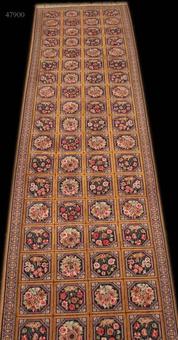New runner No. 47900 Isfahan Iran 305 x 72 cm

Larger images (will open in new window)
Please click on the thumbnails below for a larger view
| main view |
close-up |
close-up of signature |
back |
 |
 |
 |
 |
| Item Number: |
47900 |
| Name: |
Isfahan |
| Country of Origin: |
Iran |
| Size: |
305 x 72 cm (runner) |
| Age:
|
new |
| Pile: |
wool |
Foundation
(warp and weft): |
Silk |
| Design: |
geometric / allover |
| Ground Color: |
dark blue / navy / gold |
| Knots per sqm: |
800,000 |
| Remarks: |
This is a unique handmade / hand-knotted / traditional oriental carpet
The pile of this carpet is made of wool
This rug has a signature
This carpet has a total of approximately 1,760,000 knots and it took skilled carpet makers about 2,347 hours or 261 working days to hand-knot this carpet. |
 add to cart
add to cart
More about the provenance Isfahan | Iran
The city of Isfahan (also: "Esfahan") is located in South West Persia, its former name has been Aspadana. In the 17th century Isfahan was considered one of the richest and most splendid cities of the world. Isfahan is strongly related to the history of the Oriental rug. Under the reign of the Safavid kings Abbas I and Abbas II, Isfahan became the stronghold of the art of carpets. The Isfahan carpets of today are perfect reproductions ot the glorious times of Isfahan and are considered the most valuable Persian rugs.
This Oriental carpet has a so called "garden design" or as in Persian "Kheshti". The design of Oriental "garden rugs" represents sophisticated garden layouts from a bird's eye view. The oldest garden rugs date back to the 16th century. The legendary rug "Spring of Khosrow" of Khosrow the Sassanide king served as a template. The rugs are divided into fields which are separated by water ditches. The ditches in which often fish and ducks are swimming are flanked by bushes and flowers. Altogether garden rugs are an expression of the special Oriental love of floral beauty which peaked in fantastically laid out gardens.
This Oriental rug has been treated with a "Noble Finish" wash. This wash includes not only the actual cleaning of the carpet but also its processing (ennobling) which represents an increase in the Oriental carpet's value. By this special technique a soft and silky feel and shine are added to the carpet. This washing technique requires experience and skill since otherwise carpets could easily be damaged by it. In this case the washing was implemented perfectly.

